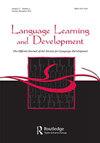The Type of Feedback Provided Can Affect Morphological Rule Learning of Young Children
IF 1.4
2区 文学
0 LANGUAGE & LINGUISTICS
引用次数: 0
Abstract
ABSTRACT The acquisition of a new morphological rule can be influenced by numerous factors, including the type of feedback provided during learning. The present study aimed to test the effect of different feedback types on children’s ability to learn and generalize an artificial morphological rule (AMR). Two groups of eight-year-olds learned to judge and produce repeated and new (generalization) items representing the AMR during ten training sessions. One group (n = 7) received only corrective feedback, that is, heard “the correct answer is … ” after each incorrect answer, whereas the other group (n = 8) received corrective feedback following verification feedback, that is, heard “incorrect, the correct answer is … .” Performance in terms of accuracy and reaction times was compared to that of an additional eight-year-old group (n = 8) from a previous study who received only verification feedback, that is, heard “incorrect” following each incorrect answer. The data analysis that was conducted for all three groups (N = 23 total), with ten observations for each child revealed that corrective feedback improved implicit learning of the AMR and in some cases also allowed generalization to new items. The combination of verification and corrective feedback, however, yielded the best performance in generalizing the AMR, possibly by stimulating both implicit and explicit processes. These preliminary findings suggest that corrective feedback, and even more so combined corrective+verification feedback, can enhance procedural and declarative learning processes of young school-age children. Future studies may be necessary to test this inference in a larger group of school-age children, and across ages.反馈类型对幼儿词形规则学习的影响
新形态规则的习得受到许多因素的影响,包括学习过程中提供的反馈类型。本研究旨在探讨不同类型的反馈对儿童人工形态规则学习和概括能力的影响。两组8岁的孩子在10次训练中学会了判断和产生代表AMR的重复和新的(概括)项目。其中一组(n = 7)只收到纠正性反馈,即每次回答错误后听到“正确答案是……”,而另一组(n = 8)在收到验证性反馈后收到纠正性反馈,即听到“不正确,正确答案是... .”。在准确性和反应时间方面的表现与先前研究中另一组8岁儿童(n = 8)进行比较,该组只收到验证性反馈,即每个不正确的答案后面都跟着“不正确”。对所有三组(N = 23)进行的数据分析,对每个孩子进行10次观察,显示纠正反馈改善了AMR的内隐学习,在某些情况下还允许对新项目的概括。然而,验证和纠正反馈的结合可能通过同时刺激内隐和外显过程,在泛化AMR方面产生了最好的性能。这些初步研究结果表明,纠正性反馈,甚至是纠正性反馈+验证性反馈的结合,可以提高学龄儿童的程序性和陈述性学习过程。未来的研究可能需要在更大的学龄儿童群体和不同年龄的儿童中检验这一推论。
本文章由计算机程序翻译,如有差异,请以英文原文为准。
求助全文
约1分钟内获得全文
求助全文

 求助内容:
求助内容: 应助结果提醒方式:
应助结果提醒方式:


